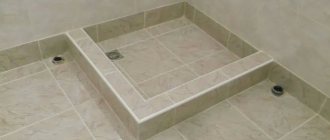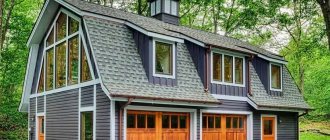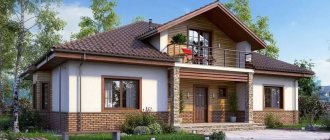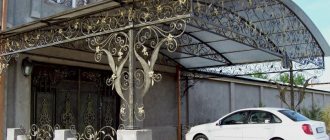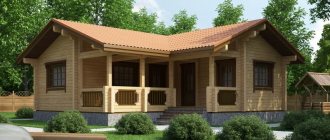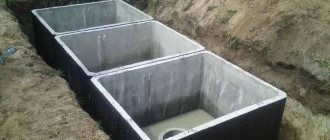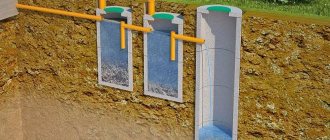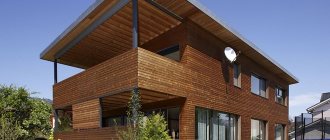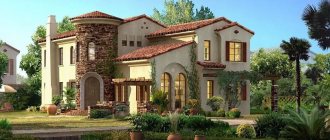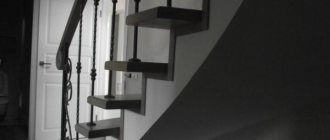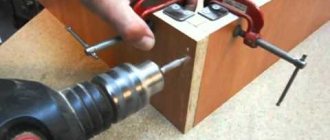Solid wood facades: types and features
Solid facades are made from a monolithic piece of wood, hence their record strength and durability. During processing, the facade is given the desired shape and design.
Along with solid ones, stacked facades are also popular. They are made of wood, but not from one board, but from many thick bars. The fragments are connected to each other using a special technology, forming a monolithic fabric. Several types of wood can be combined in one product, creating an original effect.
Regardless of the production technology, all these facades share the traditional qualities of natural wood:
Wooden facades also include veneered facades, covered with a thin layer of natural wood. The base of the structure is made of MDF or chipboard, the top decorative layer is made of veneer. With this solution, the facade completely preserves the unique texture and pattern of wood. Visually, solid and veneered furniture facades are indistinguishable from each other.
Veneering greatly reduces the cost of products while maintaining most of the original properties. Allows you to create furniture from expensive noble wood species at a reasonable price.
Tips for choosing based on purpose
When selecting furniture fronts, you need to calculate all the pros and cons. It is necessary to pay attention to the following points:
- The level of resistance of the material to high moisture and temperature changes.
- Durability and susceptibility to mechanical damage.
- Difficulty level of care.
- Estimated service life.
It is necessary to take into account both practical and aesthetic components. Glass facades in the hallway, for example, are inappropriate, because clothes will be stored behind them, the silhouette of which will not at all decorate the interior of the room.
Furniture blinds are best used in the kitchen to provide ventilation in the closet. It is not recommended to install wooden shelves and cabinets in the bathroom. Due to excessive exposure to moisture, they quickly become deformed, which will require a radical replacement of furniture. Chipboard is not acceptable for children's use due to the low level of safety. Taking into account the key features of each material, you can choose the ideal facade for any type of furniture.
The level of resistance of the material to high moisture and temperature changes
Durability and susceptibility to mechanical damage
Difficulty of care
Approximate service life
Paneled
Paneled facades are structurally a frame made of natural wood, which is filled with cheaper material. This “filling” is called the panel. The frame of paneled facades is made of wood of different species and has a thickness of 18 mm. For panels, chipboard, plywood, MDF, glass, natural or veneered wood are used. The thickness of the panel is 10 mm or more.
Paneled inserts can be flat, voluminous, stacked or floating. The latter have almost the same thickness as the frame, therefore they are the most durable and reliable.
Source
Making your own façade
Making cabinet doors with your own hands will help you save significantly on the cost of the set. Below are detailed instructions for making a paneled facade.
The most important elements of such elements are frames (frames consisting of boards with longitudinal grooves) and panels (internal panels with shaped cutters in the center). During the assembly process, the panels will need to be inserted into the frames and fixed with glue along with self-tapping screws.
| Illustration | Description of actions |
| Take measurements . Measure the parameters of your kitchen cabinets, and based on the data obtained, determine the size of the doors. To do this, subtract 3 mm from the width and height of the opening. You can calculate the parameters of the panel by adding 2 cm to the total width of the crossbars. For one door you will need 5 elements - one panel, as well as 2 crossbars and vertical posts. | |
| Cut out the parts . Using a jigsaw, cut the array into posts and crossbars. Using a milling machine, make grooves with a depth of 10 mm and a width of 6 mm in the side cut of each element. At the ends of the crossbars, form longitudinal tenons with a size of 10x6 mm. Make marks on a piece of plywood and cut out the panel. Sand the surface of the boards and sand the edges with sandpaper. | |
| Start assembly . Insert the edges of the panel into the grooves of the vertical post, and place the bottom crossbar on the plywood. Connect the sides to the crossbar tenons. Then secure the top crossbar. If all the elements are easily connected together and fit tightly together, you can disassemble all the tenons, grooves and edges of the panel. Now coat all joints with wood glue and reassemble the base. To strengthen the fixation, you can use clamps. | |
| Do the finishing . After the glue has dried, sand all the joints and treat the door itself with an antiseptic compound. Then treat the surface with paint or varnish. Instead of plywood, you can insert glass, colored polycarbonate, a thin board or a plastic panel into the frame. | |
| Install the fittings. Upon completion of the finishing work, secure the hinges and handles to the walls of the box. |
You will get more visual information about creating a headset with your own hands from the video in this article. Solid wood kitchen facades made according to this design will not only become a worthy decoration of your kitchen. They will also be a reason for your pride - and at the same time, well-deserved pride!
What is a paneled façade?
What is a panel? Paneling in the furniture industry is a decorative element that decorates walls, doors and facades. The word itself is derived from the German word meaning “to fill.” Therefore, the panel is a wooden panel that is inserted into the facade frame. Most often it is used to decorate kitchen units, interior doors or cabinets.
The basis for the panel is solid wood or MDF. As a rule, it is made in the shape of a rectangle, but sometimes the shape may differ from the standard. Laminated chipboard, glass, chipboard plywood and even natural veneer can also be used for production.
The main function of the panel is interior decoration. It creates an accent in the room and adds charm to it. It can often be seen in the kitchen as an addition to solid wood furniture.
Why is she popular? Any manufacturer of furniture facades can find options with panels in their catalogue. Why?
In addition to the obvious aesthetic appearance, paneled facades have a number of positive qualities. Firstly, it significantly reduces the weight of the furniture. Paneled facades are less heavy, so they do not sag or deform over time. The design allows you to replace damaged parts with new ones without effort. It is easy to restore, so if it breaks, you won’t have to think about buying other facades.
It is resistant to changes in temperature and humidity in the room. The insert will not dry out over time. It will not show small cracks or signs of rotting, which will deteriorate the appearance of the product. The moisture resistance of the panel protects it from the formation of mold, which makes it indispensable in the kitchen.
Due to their versatility, they can change their appearance. The inserts can be replaced with thinner or wider ones, and completely transform the design to your taste.
Types of panels Today, the furniture market offers many options for panels:
Style and grace: paneling in decor We have sorted out the advantages and features. But clients do not choose it because of its strength and moisture resistance. First of all, they are attracted by how it will look in the room. Can paneling really suit any style?
The panel is unique in that it will fit into the interior without any problems. Solid wood is not influenced by fashion and does not become outdated in a few years. The panel will look harmonious in eco-style, Provence, classic and even minimalism. A variety of colors and a wide selection of patterns allow you to choose an element that suits the headset.
For a classic style with a solid and heavy decor, you should look at paneled facades with massive parts. It will add luxury and elegance to the room. For a more restrained and simple Scandinavian style, a panel without fancy inserts is suitable. And in the case of modern or country, you can give free rein to your imagination and experiment with shape and color.
Paneled facades will bring novelty to the interior and become a “highlight” that is easy to pay attention to. The main thing is to provide the client with a choice of shades and patterns so that he can find the right option.
Source
Materials
Not only the appearance of paneled doors depends on the material of manufacture, but also the characteristics, margin of safety and reliability, as well as cost.
To make the frame of the door leaf, take a solid wooden beam . Not only wood, but also other materials are suitable for insertion. This already turns out to be a combined type of product.
Wooden versions of products involve the use of soft varieties and more durable valuable species. A pine, cherry or spruce door will not cost very much. Oak, teak, beech, and walnut are considered more valuable and durable. Red and black trees belong to the elite class.
Article on the topic: Plastic furniture: how to choose reviews
Important! Wood structures can combine several species. Therefore, in order to prevent the destruction of the panel due to changes in temperature and humidity, you need to clarify this nuance with the seller before purchasing.
Inexpensive combined models combine MDF sheets, plywood, chipboard, and pressed paper. Blind inserts are covered with leather or its substitute. Whiter, more interesting products are obtained through the use of glass. It can be regular, matte, colored, embossed, stained glass, with photo printing or oracal, etc.
Frame facades: types and features of furniture paneled facades
The facades of a furniture set determine its attractiveness from the outside, helping to create an atmosphere of comfort and coziness in the room. At the same time, they are subject to great working requirements - the front panels of furniture must withstand high temperatures, be moisture-resistant and durable.
Paneled (framed) facades, which advantageously combine practicality and modern design, are in demand.
Paneled facades - what are they? Specifics and advantages of the design
Framed facades are structures consisting of two components: a base and a frame.
Such designs are sometimes called paneled - from the word “panel” (German “fullung” - “filling”), which means a quadrangular-shaped decorative component placed in a frame.
The positive qualities of frame panels include:
The facades of physical panels are not constructed heavily: thin panels are placed in the frame, which is already ready, and are fixed in specialized grooves using shaped overlays. To secure the structure, specialized glazing beads are used, which are placed on glue or nails.
Elimination of door sagging
The most common problem that owners of wooden doors often encounter is their sagging and hitting the bottom of the frame. In this case, it is worth inspecting the hinges very carefully - during installation, screws with incorrectly selected threads could be used. Such fasteners quickly unscrew from their seats, which leads to loosening of the hinges. This situation implies the easiest way to correct the defect - select screws with sharp threads and screw the hinges tightly into place. If necessary, it is possible to replace standard screws with longer ones, but with the same head diameter.
Types of furniture paneled facades
Framing for panels can be made from a variety of materials:
Chipboard frames are very popular due to their reduced price. Otherwise, they are not so flawless - they cannot boast of durability, they absorb moisture and odors.
MDF structures are considered one of the best combinations of reasonable price and excellent quality. Medium-density fiberboard framing is environmentally friendly, safe and resistant to adverse external factors.
A frame furniture façade made of real wood will cost much more, but is very popular due to the ability to give the furniture a noble look. Basically, MDF, trimmed with veneer - a thin layer of wood - is used as a panel in such products. From the outside and to the touch, such panels are indistinguishable from solid solid wood facades.
Aluminum frames are distinguished by their very high resistance to wear, hygiene and durability. Also, they are great for the interiors of our time.
Dimensions for different types of furniture
Despite the rapidly growing popularity of furniture of non-standard shapes, most manufacturers focus on traditional models. This is at least economically beneficial. The demand for conventional rectangular, cabinet cabinets and walls has always been high. There are quite a lot of options for standard sizes of furniture facades, so you can choose a suitable element for rooms of any size.
Review of furniture LED lamps, methods of placing devices
| Blind doors, in cm | Showcases, cm | Drawers and cabinets, cm |
| 39.5 x 49.5 | 49.5 x 49.5 | 14 x 29.5 |
| 57 x 29.5 | 57 x 29.5 | 14 x 39.5 |
| 71.5 x 29.5 | 71.5 x 29.5 | 28.5 x 39.5 |
| 71.5 x 59.5 | 90 x 29.5 | 11 x 59.5 |
The indicated dimensions are relevant for facades made of all types of materials. Compliance with them guarantees convenient use of furniture. But it is worth noting that the data may differ slightly from different manufacturers, by 3–5 mm.
As for sliding wardrobes, the width of the doors can vary from 50 cm to 1 m, and the height can range from 220 to 240 cm. Each manufacturer sets its own parameters for facades.
Types of internal filling of a frame facade
Depending on the shape, panel inserts can be:
Floating panels are considered an excellent option for rooms where humidity almost always changes, for example, a kitchen or bathroom - they do not cause distortions and cracks in the facade when the size of the inserts changes under the influence of unsaturated air.
Depending on the material, the panels can be:
The insert usually has not only a square and quadrangular shape. In individual artistic projects for furniture sets, there are also round, oval, trapezoidal and even polygonal panels.
The frame front of the cabinet looks great on its own, but it is often further decorated with:
The panels made from pieces of various materials look original.
Design of the style of paneled facades
Physical panel facades have been used since the Middle Ages and have not lost their former popularity.
Designers nowadays are guided by the experience of centuries-old foundations and offer panels suitable for a variety of style solutions:
Cabinet fronts made in modernist styles, for example, minimalism or hi-tech, are distinguished by clear lines and little decoration.
Paneled furniture facades - types and features
Corner orthopedic sofa - how to choose? Types of models and features.
Orthopedic sofa for daily sleep - which one is better to choose?
Orthopedic sofas - types of models and design. How to choose?
Recliner chair - types, design and features
Office chairs for staff - types, design, selection rules
Loft bed with wardrobe: design and selection rules
Furniture facades are responsible for the appearance of products, and at the same time must have high performance characteristics. There are two options for their execution: panel and frame. The second type is considered more interesting in terms of design. It is also not without other advantages, so it is quite in demand.
Basic designs
Based on the type of construction, the following types of facades are distinguished:
- Straight - such facades have standard sizes, are considered the simplest of all possible, and are used in the manufacture of traditional cabinet furniture.
- Bent - can be convex, concave, used for more sophisticated interior styles, must correspond to the frame of the product.
- Radius - suitable for walls, cabinets, visually increasing the space.
- Blind elements look original and are easy to use.
If radius or curved ones were chosen from the main types of furniture facades, one nuance should be taken into account. Their dimensions must be calculated to the nearest millimeter. Even a small error can cause rapid breakdown of the product. Moreover, in this case, minor repairs will not be enough; one or more facades will have to be replaced.
Direct
Bent
Radial
Louvre
Paneled facade - design features
The frame facade of the cabinet is a structure consisting of a frame and an insert. The latter is also called panel, which translated from German means “filling”. Thin shields are placed in a finished frame, which has special grooves. The elements are fixed using glazing beads placed on glue or nails.
Paneled facades have the following advantages:
Advantages and disadvantages
From all of the above, we can conclude that paneled doors have the following advantages , such as:
- Decorative and aesthetic appearance.
- Thanks to the thin insert, the weight of the canvas is reduced.
- The structure can be disassembled with the replacement and restoration of its elements.
- The durability of the structure is determined by the presence of an insert made of a different material. After all, a solid massif of soft rocks can dry out within a few years.
- Reducing prices by reducing the amount of material and replacing expensive elements with cheaper analogues.
Article on the topic: How to place furniture in a kitchen 5 meters
The use of low-quality raw materials and non-compliance with the rules of technology during production are shortcomings that depend on the integrity of the manufacturers and are entirely on their conscience. In general, loin doors are an ideal option and can be installed in any home.
Thus, the panel is the central part of the door, which is distinguished by a number of positive features and often has an aesthetic function, as it is shaped into a variety of shapes, decorated and made from a variety of materials.
Types of panels
Depending on the configuration, panels are presented in several types.
To make the insert, you can choose almost any material, which allows you to create original combinations. Usually used:
Wood boards are finished in different ways:
Frame facades are decorated using carved and forged overlays, by creating stacked panels from different materials.
Glass and mirror inserts can be complemented with sandblasted images, stained glass painting or fusing elements.
Features of door repair
The main reasons for restoration of wooden doors:
— subsidence of structures caused by failure of hinges or the use of unsuitable fasteners;
- weakly reinforced boxes;
— wear of various fragments of the door leaf;
— unsticking and warping of panels;
- poor opening and closing, the appearance of extraneous sounds.
— the need to eliminate deficiencies in external finishing.
Styling
The frame furniture façade must fit harmoniously into the overall style of the interior, so it is important to pay attention to the characteristic details.
Furniture products with framed facades make it possible to make the interior unique due to the variety of possible materials. However, when choosing, you should take into account the purpose and installation location of the structures. Models for the kitchen and bathroom must first of all be highly resistant to moisture, temperature changes, and easy to clean from dirt.
Source
Design
Thanks to the almost unlimited variety of materials used, a paneled door can reflect any style and design . Therefore, choosing the optimal model that meets the requirements of a certain interior style is not so difficult.
For living rooms, kitchens, and living rooms, panel doors with translucent inserts are usually selected. In fact, the ideal solution is to purchase a canvas with glass in the central part. Of course, blind inserts are more suitable for bathrooms and toilets. However, this does not mean that the choice seems boring. A unique interior can be achieved by decorating doorways in one style.
an important role in the process of creating a wide palette of models of any style. Thanks to coatings such as PVC, veneer, laminate, etc., as well as various cutters, a variety of inserts is achieved. They can be straight or curly in shape, contain additional overlays, carvings, volumetric elements, or elaborate relief. Over time, it is possible to replace the boring middle.
If the paneled door has glass, then you can show your imagination and put a design on it, cover it with a film with a pattern, photograph or any other image, and also turn it into a stained glass window. This design knows no boundaries.
